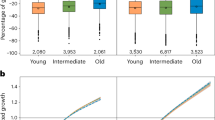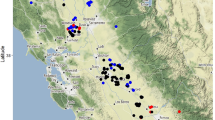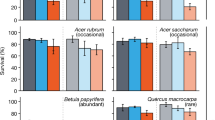Abstract
For long-lived organisms, investment in insurance strategies such as reserve energy storage can enable resilience to resource deficits, stress or catastrophic disturbance. Recent fire in California damaged coast redwood (Sequoia sempervirens) groves, consuming all foliage on some of the tallest and oldest trees on Earth. Burned trees recovered through resprouting from roots, trunk and branches, necessarily supported by nonstructural carbon reserves. Nonstructural carbon reserves can be many years old, but direct use of old carbon has rarely been documented and never in such large, old trees. We found some sprouts contained the oldest carbon ever observed to be remobilized for growth. For certain trees, simulations estimate up to half of sprout carbon was acquired in photosynthesis more than 57 years prior, and direct observations in sapwood show trees can access reserves at least as old. Sprouts also emerged from ancient buds—dormant under bark for centuries. For organisms with millennial lifespans, traits enabling survival of infrequent but catastrophic events may represent an important energy sink. Remobilization of decades-old photosynthate after disturbance demonstrates substantial amounts of nonstructural carbon within ancient trees cycles on slow, multidecadal timescales.
This is a preview of subscription content, access via your institution
Access options
Access Nature and 54 other Nature Portfolio journals
Get Nature+, our best-value online-access subscription
$29.99 / 30 days
cancel any time
Subscribe to this journal
Receive 12 digital issues and online access to articles
$119.00 per year
only $9.92 per issue
Buy this article
- Purchase on Springer Link
- Instant access to full article PDF
Prices may be subject to local taxes which are calculated during checkout





Similar content being viewed by others
Data availability
Radiocarbon data are provided in Supplementtary Information, and other data are archived at https://doi.org/10.5281/zenodo.10010942.
Code availability
Simulation code is archived at https://doi.org/10.5281/zenodo.10010942.
References
Ogle, K. & Pacala, S. W. A modeling framework for inferring tree growth and allocation from physiological, morphological and allometric traits. Tree Physiol. 29, 587–605 (2009).
Fisher, R. A. et al. Taking off the training wheels: the properties of a dynamic vegetation model without climate envelopes, CLM4. 5 (ED). Geosci. Model Dev. 8, 3593–3619 (2015).
Koven, C. D. et al. Benchmarking and parameter sensitivity of physiological and vegetation dynamics using the Functionally Assembled Terrestrial Ecosystem Simulator (FATES) at Barro Colorado Island, Panama. Biogeosciences 17, 3017–3044 (2020).
Epron, D. et al. Pulse-labelling trees to study carbon allocation dynamics: a review of methods, current knowledge and future prospects. Tree Physiol. 32, 776–798 (2012).
Carbone, M. S. et al. Age, allocation and availability of nonstructural carbon in mature red maple trees. New Phytol. 200, 1145–1155 (2013).
Huang, J. et al. Storage of carbon reserves in spruce trees is prioritized over growth in the face of carbon limitation. Proc. Natl Acad. Sci. USA 118, e2023297118 (2021).
Speer, J. H., Swetnam, T. W., Wickman, B. E. & Youngblood, A. Changes in pandora moth outbreak dynamics during the past 622 years. Ecology 82, 679–697 (2001).
Bär, A., Michaletz, S. T. & Mayr, S. Fire effects on tree physiology. New Phytol. 223, 1728–1741 (2019).
Tanner, E. V., Rodriguez-Sanchez, F., Healey, J. R., Holdaway, R. J. & Bellingham, P. J. Long-term hurricane damage effects on tropical forest tree growth and mortality. Ecology 95, 2974–2983 (2014).
Dietze, M. C. et al. Nonstructural carbon in woody plants. Annu. Rev. Plant Biol. 65, 667–687 (2014).
Vargas, R., Trumbore, S. E. & Allen, M. F. Evidence of old carbon used to grow new fine roots in a tropical forest. New Phytol. 182, 710–718 (2009).
Koch, G. W., Sillett, S. C., Jennings, G. M. & Davis, S. D. The limits to tree height. Nature 428, 851–854 (2004).
Sillett, S. C. et al. How do tree structure and old age affect growth potential of California redwoods? Ecol. Monogr. 85, 181–212 (2015).
Curtis, P. S. et al. Biometric and eddy-covariance based estimates of annual carbon storage in five eastern North American deciduous forests. Agric. For. Meteorol. 113, 3–19 (2002).
Woodward, B. D., Romme, W. H. & Evangelista, P. H. Early postfire response of a northern range margin coast redwood forest community. For. Ecol. Manag. 462, 117966 (2020).
Brown, P. M. & Baxter, W. T. Fire history in coast redwood forests of the Mendocino Coast, California. Northwest Sci. 77, 147–158 (2003).
Brown, P. M. & Swetnam, T. W. A cross-dated fire history from coast redwood near Redwood National Park, California. Can. J. Res. 24, 21–31 (1994).
Lazzeri-Aerts, R. & Russell, W. Survival and recovery following wildfire in the southern range of the coast redwood forest. Fire Ecol. 10, 43–55 (2014).
Safford, H. D., Paulson, A. K., Steel, Z. L., Young, D. J. N. & Wayman, R. B. The 2020 California fire season: a year like no other, a return to the past or a harbinger of the future? Glob. Ecol. Biogeogr. 31, 2005–2025 (2022).
Stephens, S. L. & Fry, D. L. Fire history in coast redwood stands in the northeastern Santa Cruz mountains, California. Fire Ecol. 1, 2–19 (2005).
Trumbore, S. E., Sierra, C. A. & Pries, C. H. Radiocarbon nomenclature, theory, models, and interpretation: measuring age, determining cycling rates, and tracing source pools. In Radiocarbon and Climate Change: Mechanisms, Applications and Laboratory Techniques (eds. Schuur, A. G. E. et al.) pp. 45–82 (Springer, 2016).
Hua, Q. et al. Atmospheric radiocarbon for the period 1950–2019. Radiocarbon 64, 723–745 (2022).
Richardson, A. D. et al. Distribution and mixing of old and new nonstructural carbon in two temperate trees. New Phytol. 206, 590–597 (2015).
Muhr, J. et al. How fresh is maple syrup? Sugar maple trees mobilize carbon stored several years previously during early springtime sap-ascent. New Phytol. 209, 1410–1416 (2016).
D’Andrea, E. et al. Winter’s bite: beech trees survive complete defoliation due to spring late-frost damage by mobilizing old C reserves. New Phytol. 224, 625–631 (2019).
Muhr, J., Trumbore, S., Higuchi, N. & Kunert, N. Living on borrowed time–Amazonian trees use decade-old storage carbon to survive for months after complete stem girdling. New Phytol. 220, 111–120 (2018).
Trumbore, S., Czimczik, C. I., Sierra, C. A., Muhr, J. & Xu, X. Non-structural carbon dynamics and allocation relate to growth rate and leaf habit in California oaks. Tree Physiol. 35, 1206–1222 (2015).
Herrera-Ramírez, D. et al. Probability distributions of nonstructural carbon ages and transit times provide insights into carbon allocation dynamics of mature trees. New Phytol. 226, 1299–1311 (2020).
Peltier, D. et al. An incubation method to determine the age of available nonstructural carbon in woody plant tissues. Tree Physiol. (in the press).
Fink, S. Some cases of delayed or induced development of axillary buds from persisting detached meristems in conifers. Am. J. Bot. 71, 44–51 (1984).
Waters, D. A., Burrows, G. E. & Harper, J. D. Eucalyptus regnans (Myrtaceae): a fire-sensitive eucalypt with a resprouter epicormic structure. Am. J. Bot. 97, 545–556 (2010).
Pausas, J. G. & Keeley, J. E. Epicormic resprouting in fire-prone ecosystems. Trends Plant Sci. 22, 1008–1015 (2017).
Richards, J. H. et al. Tropical tree species differ in damage and mortality from lightning. Nat. Plants 8, 1007–1013 (2022).
Schutz, A. E. N., Bond, W. J. & Cramer, M. D. Juggling carbon: allocation patterns of a dominant tree in a fire-prone savanna. Oecologia 160, 235–246 (2009).
Bentrup, C. Carbon Limitation of Height Growth: Evidence from Sequoia sempervirens (Northern Arizona Univ., 2009).
Sillett, S. C. et al. Rangewide climatic sensitivities and non-timber values of tall Sequoia sempervirens forests. For. Ecol. Manag. 526, 120573 (2022).
Sillett, S. C., Van Pelt, R., Carroll, A. L., Campbell-Spickler, J. & Antoine, M. E. Aboveground biomass dynamics and growth efficiency of Sequoia sempervirens forests. For. Ecol. Manag. 458, 117740 (2020).
Douhovnikoff, V., Cheng, A. M. & Dodd, R. S. Incidence, size and spatial structure of clones in second-growth stands of coast redwood, Sequoia sempervirens (Cupressaceae). Am. J. Bot. 91, 1140–1146 (2004).
PRISM Climate Group. Oregon State University. https://prism.oregonstate.edu. Accessed 23 Sep 2022.
Burgess, S. S. O. & Dawson, T. E. The contribution of fog to the water relations of Sequoia sempervirens (D. Don): foliar uptake and prevention of dehydration. Plant Cell Environ. 27, 1023–1034 (2004).
Carbone, M. S. et al. Flux Puppy—an open-source software application and portable system design for low-cost manual measurements of CO2 and H2O fluxes. Agric. For. Meteorol. 274, 1–6 (2019).
Landhäusser, S. M. et al. Standardized protocols and procedures can precisely and accurately quantify non-structural carbohydrates. Tree Physiol. 38, 1764–1778 (2018).
Lowe, D. C. Preparation of graphite targets for radiocarbon dating by tandem accelarator mass spectrometer (TAMS). Int. J. Appl. Radiat. Isot. 35, 349–352 (1984).
Vogel, J. S., Southon, J. R., Nelson, D. E. & Brown, T. A. Performance of catalytically condensed carbon for use in accelerator mass spectrometry. Nucl. Instrum. Methods Phys. Res. B 5, 289–293 (1984).
Synal, H.-A., Stocker, M. & Suter, M. MICADAS: a new compact radiocarbon AMS system. Nucl. Instrum. Methods Phys. Res. B 259, 7–13 (2007).
Stuiver, M. & Polach, H. A. Discussion reporting of 14C data. Radiocarbon 19, 355–363 (1977).
Reimer, P. J., Brown, T. A. & Reimer, R. W. Discussion: reporting and calibration of post-bomb 14C data. Radiocarbon 46, 1299–1304 (2004).
Sierra, C. A., Müller, M. & Trumbore, S. E. Modeling radiocarbon dynamics in soils: SoilR version 1.1. Geosci. Model Dev. 7, 1919–1931 (2014).
Reimer, P. J. et al. IntCal13 and Marine13 radiocarbon age calibration curves 0–50,000 years cal BP. Radiocarbon 55, 1869–1887 (2013).
Acknowledgements
This work was funded by NSF-IOS-RAPID number 2053337 and grant number 149 from the Save-the-Redwoods League. The incubation method we used was developed under NSF-IOS-RAPID number 1936205. We thank J. Kerbavaz and the staff at BBRSP for allowing research access soon after the fire. We thank J. Campbell-Spickler for assistance in installing canopy PhenoCams. We gratefully acknowledge the financial support of the Office of the President and Vice President of Research at Northern Arizona University for acquisition of the MICADAS.
Author information
Authors and Affiliations
Contributions
M.S.C., G.K. and A.D.R. conceived of the study. M.E. surveyed and selected study trees, and G.K., A.D.R., J.L., M.E. and D.M.P.P. collected the data. M.C.M. and A.M.T. contributed additional carbohydrate measurements and analysis. D.M.P.P., M.S.C. and A.D.R. analysed the data, and D.M.P.P. wrote the first draft of the manuscript with M.S.C., G.K. and A.D.R. All authors substantially contributed to revisions.
Corresponding author
Ethics declarations
Competing interests
The authors declare no competing interests.
Peer review
Peer review information
Nature Plants thanks Jordi Martinez-Vilalta, Frida Piper and Adrian Rocha for their contribution to the peer review of this work.
Additional information
Publisher’s note Springer Nature remains neutral with regard to jurisdictional claims in published maps and institutional affiliations.
Supplementary information
Supplementary Information
Supplementary Figs. 1–5 and Supplementary Table 1.
Supplementary Table
Table 1. Full radiocarbon dataset including all measured sprouts, chia plant samples and sapwood incubations. We report fraction modern (F14C), Δ14C and associated AMS analytical error in ‰. For sprouts, replicates within collection date were measured to understand within-sprout (for example, top/bottom, leaves/stem) or within-tree variation, but while differences were sometimes considerable no systematic patterns were observed, and so we report all observations. For sapwood incubations, tissue denotes sapwood depth, where for April 2021 collections 1 and 2 indicate shallow and deep sapwood halves, respectively. For April 2022 incubations were sampled as finely as possible, typically eighths denoted by 1–8; some samples were lost.
Rights and permissions
Springer Nature or its licensor (e.g. a society or other partner) holds exclusive rights to this article under a publishing agreement with the author(s) or other rightsholder(s); author self-archiving of the accepted manuscript version of this article is solely governed by the terms of such publishing agreement and applicable law.
About this article
Cite this article
Peltier, D.M.P., Carbone, M.S., Enright, M. et al. Old reserves and ancient buds fuel regrowth of coast redwood after catastrophic fire. Nat. Plants 9, 1978–1985 (2023). https://doi.org/10.1038/s41477-023-01581-z
Received:
Accepted:
Published:
Issue Date:
DOI: https://doi.org/10.1038/s41477-023-01581-z
This article is cited by
-
Scorched Earth
Nature Plants (2024)



